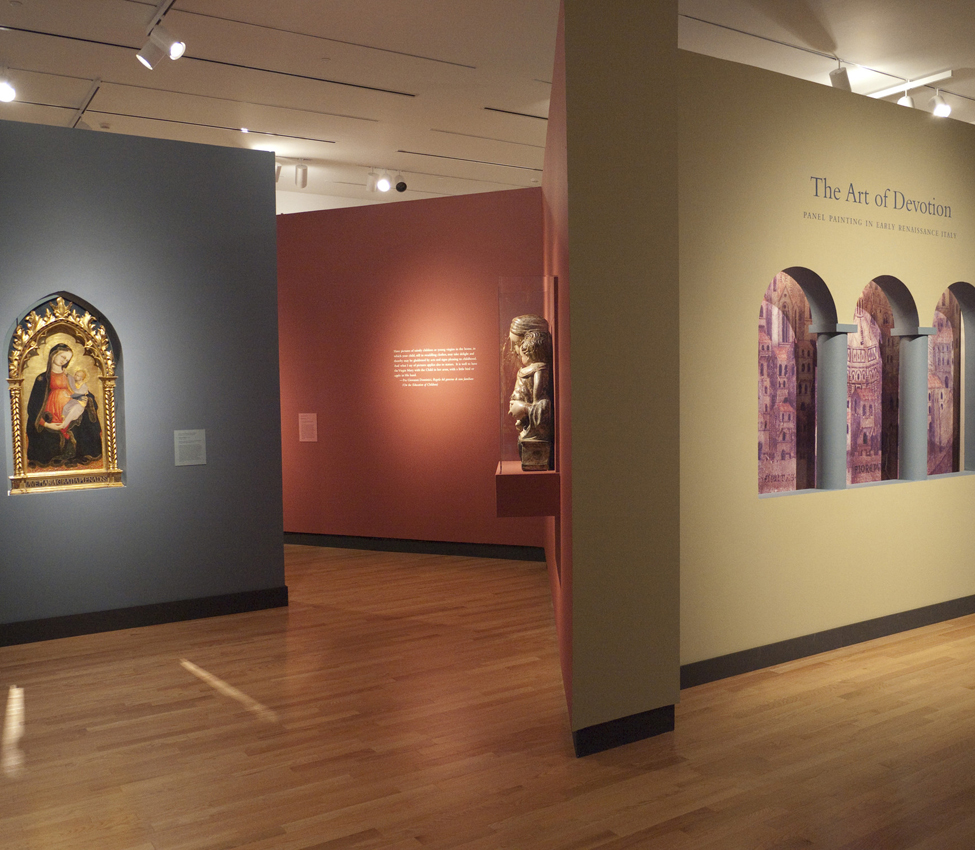December 29, 2010
The Art of Devotion: Panel Painting in Early Renaissance Italy
February 9–May 30, 2010
The act of devotion in Renaissance Italy was undeniably a matter of business and craft, as well as an aesthetic and religious experience. This intersection is clearly captured in an important exhibition of early 15th-century Italian paintings and sculptures opening at the Mount Holyoke College Art Museum on February 9. Entitled The Art of Devotion: Panel Painting in Early Renaissance Italy, the exhibition reveals the place of art in the lives of early Renaissance patrons and addresses such themes as artistic training and technique, function, and patronage during the period as well as current issues in the conservation of these fragile works.
At heart a collaborative venture, the creation of early 15th-century panel paintings in Italy depended upon a tight network of painters, woodworkers, gilders, and the patrons who drove demand for large-scale altarpieces as well as for smaller devotional objects intended for domestic interiors. The works of art that resulted from these transactions served both as a focus for public and private devotion and as an emphatic statement about the wealth and status of the patrons who commissioned them.
The Art of Devotion includes paintings and sculptures designed for a range of spaces and devotional functions. Two large triptychs, one attributed to Lippo d’Andrea (Yale University Art Gallery) and another by Ventura di Moro (Grassi Studio), represent the elaborate panel paintings that were commissioned by significant 15th-century patrons for public churches. This custom was both pious and self-serving, as patrons sought the assurance of salvation through their acts of economic generosity. In those objects created for the home, the quantity of precious pigments, from lapis lazuli to gold leaf, would have confirmed the owner’s piety, while at the same time communicating much about his wealth and taste. Although small in scale, richly decorated panels such as the Virgin and Child, attributed to the Master of 1419 (Ackland Museum of Art at the University of North Carolina) underscore this reality.
Tradition and innovation have long been seen as complementary forces in the development of Italian Renaissance art. Yet while surveys of this period tend to focus on the innovative departures of artists such as Masaccio, Ghiberti, and Brunelleschi, this exhibition focuses on their counterparts ― artists valued for their knowledge of and appreciation for tradition. Through apprenticeship and training, a young artist learned the techniques of the day while absorbing the style of his master. In this way, artists such as Ventura di Moro, Lippo d’Andrea, and Giovanni dal Ponte carried forward approaches to iconography, composition, and style established by a preceding generation. A display of their materials and techniques constitutes an important element in the exhibition; on March 4 painting conservator Anne O’Connor will demonstrate their methods at 4:30 p.m. in a lecture demonstration at Mount Holyoke College Gamble Auditorium.
This collaborative exhibition, set in motion by the Middlebury College Museum of Art’s acquisition of a panel painting by Lippo d’Andrea, includes six works from the Mount Holyoke College Art Museum’s distinguished collection of Renaissance and medieval sculpture, as well as 14 significant works from ten national and international collections. It is made possible in part through grants from the Robert Lehman Foundation and the Samuel H. Kress Foundation. Additional funding at Mount Holyoke is provided by the Warbeke Art Museum Fund, the Rebekah B. Wills Fund, and the Mount Holyoke College Art Museum Friends of Art Fund.
Admission to the exhibition and to the Museum is free; donations are welcome. The galleries are open Tuesday–Friday, 11 a.m.–5 p.m., and Saturday and Sunday, 1-5 p.m. The Museum is fully accessible. Parking is available nearby.
The Mount Holyoke College Art Museum in South Hadley is a leading collegiate art museum. Its comprehensive permanent collection of 15,000 objects features Asian art, 19th- and 20th-century European and American paintings and sculpture, Egyptian, Greek, and Roman art, medieval sculpture, early Italian Renaissance paintings, and an extensive collection of works on paper. For more information, visit www.mtholyoke.edu/artmuseum or call 413.538.2245.
Images are available upon request.
RELATED EVENTS
Thursday, 11 February, 4:30 p.m.
Gamble Auditorium, Art Building
Exhibition opening and reception
“Competitive in Spirit, Collaborative in Nature: Panel Painting in Early Renaissance Florence”
Lecture by Katherine Smith Abbott, Visiting Professor, Department of the History of Art and Architecture,
Middlebury College
Thursday, 25 February, 4:30 p.m.
Gamble Auditorium, Art Building
“The Mythical Triumph of Gothic Style in Early Renaissance Florence”
Lecture by Laurence Kanter, Lionel Goldfrank III Curator of European Art, Yale University Art Gallery
Reception to follow
Thursday, 4 March, 4:30 p.m.
Gamble Auditorium, Art Building
“Art in the Making: Materials and Techniques of Early Italian Painting”
Demonstration and lecture by Anne O’Connor, painting conservator
Reception to follow
Thursday, 25 March, 4:30 p.m.
Gamble Auditorium, Art Building
“The Artist at Work: Lorenzo Ghiberti”
Lecture by Wendy Watson, Curator, Mount Holyoke College Art Museum

 GIVE
GIVE